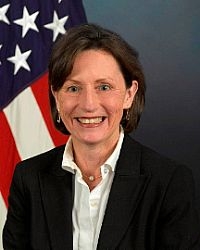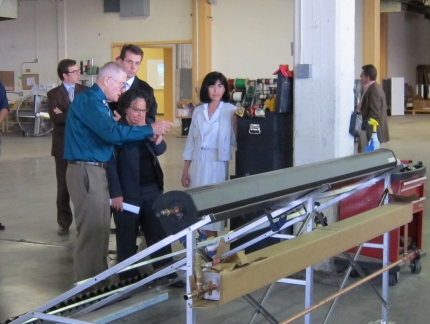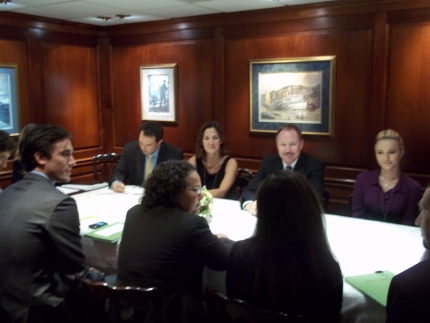Council on Environmental Quality Blog
Modernizing Our Electric Grid, Creating Jobs
Posted by on October 5, 2011 at 6:10 PM EDTToday the Obama Administration announced it would accelerate the permitting and construction of seven proposed electric transmission lines. This move will speed the creation of thousands of construction and operations jobs while transforming the Nation's electric system into a modern, 21st century grid that is safer and more secure, and gives consumers more energy choices. This announcement follows in a long line of this Administration's initiatives that demonstrate the commitment to job creation and modernizing America's infrastructure. See what stakeholders are saying below:
Pam Eaton, Deputy Vice President for Public Lands, The Wilderness Society:
"Building responsibly-sited power lines to access world-class renewable resources can put thousands of Americans to work, bring cost-effective clean power to people who need it, and help some of the rural counties in the West hardest hit by the economic downturn. We are counting on the Administration to focus its laser-beam attention on those lines that will truly bring our best renewable energy resources online efficiently and effectively with special attention to safeguarding our unique Western landscapes and communities."David G. DeCampli, president of PPL Electric Utilities, and Ralph LaRossa, president of PSE&G:
"We applaud the administration's efforts to ensure that high-priority electric infrastructure projects are built and placed in service in a timely way. The Susquehanna-Roseland transmission line will improve electric service reliability for millions of people. As an added benefit, its construction will create thousands of jobs."Tom C. Wray, Project Manager, SunZia LLC:
"The SunZia Transmission Project welcomes the creation of the Administration's Rapid Response Team and its focus on federal agency process improvements for environmental reviews and permit issuances. The preparation of SunZia's Draft Environmental Impact Statement is in its 27th month and the prospect for interagency cooperation to obtain expeditious review is a very positive development. The RRTT's coordination and oversight is a needed and welcome evolution in what can become an otherwise an unnecessarily lengthy, difficult process."Carl Zichella, Director of Western Transmission, NRDC:
"The Obama administration believes, and so does NRDC, that we can accelerate transmission approvals without cutting corners on environmental or cultural reviews. This pilot program demonstrates that enhanced coordination can play a critical role in accomplishing the President's clean energy goal and cut emissions in the West by 80% in 2050. We look forward to contributing, both through the interconnection planning efforts now underway and directly with the agencies implementing the program."See CEQ's initiatives for more information on the Rapid Response Team for Transmission.
Neal Kemkar is Deputy Associate Director for Energy and Climate Change at the White House Council on Environmental Quality
Learn more about Energy and EnvironmentImproving the Health of our Children and Communities: the Clean Air Act
Posted by on October 4, 2011 at 2:00 PM EDTAdopted into law more than forty years ago, the Clean Air Act represents our fundamental commitment to the health and wellbeing of America's communities and children. Throughout its history, the Act has been supported and strengthened by leaders in both political parties. Today, however, some voices in Congress want to use the economic crisis as an excuse to weaken clean air protections for the first time in history. But as we have known for decades, we do not need to sacrifice the health of the American people to build a stronger economy. In fact, the health of our economy depends on the health of our communities.
By any measure, the Clean Air Act has been a successful investment. Last year alone, Clean Air Act regulations prevented approximately 160,000 premature deaths, 130,000 heart attacks, and 1.7 million asthma attacks, delivering roughly $30 in benefits for every dollar spent. These health gains have directly boosted our productivity. In 2010, Americans avoided an estimated 13 million lost work days and 3 million lost school days thanks to Clean Air Act standards. Finally, the Act has been a catalyst for innovation, making the U.S. a world leader in advanced pollution controls and clean technologies. U.S. exports from the environmental technology industry in 2008 were over $43 billion.
Today, even as Americans use more electricity and drive more miles, local air pollution has fallen thanks to the Clean Air Act. But many large sources of pollution remain unaddressed and our families bear the costs of this pollution every day. The Administration is taking a number of important steps to meet our national commitment to clean air and reduce the dangers associated with air pollution that continues to impact the health of our communities, particularly our most vulnerable populations, including children and seniors.
For example, these communities would benefit from new rules for power plants that will set first-ever national limits for mercury, arsenic and other toxic chemicals and slash emissions of soot and smog that pollute the air we breathe. While most of the country's power plants have already installed readily available pollution controls, others, including many plants older than the Clean Air Act itself, continue to operate without modern controls. These long-awaited public health standards will also finally provide a more level playing field for companies, enable investments that are currently on hold, and create jobs building, installing and operating pollution control equipment and new clean sources of electricity.
However, these vital public health standards, overdue by more than a decade and required by court orders, would be blocked and delayed indefinitely by a bill that recently passed the House of Representatives, the TRAIN Act. The costs of this bill would be massive. Each year of delay imposed by this bill would lead to tens of thousands of premature deaths, tens of thousands of heart attacks, thousands of hospital visits for respiratory and cardiovascular disease, and hundreds of thousands of childhood asthma attacks and other respiratory illnesses that would otherwise be avoided by commonsense public health standards.
This is just the first in a line of bills attacking core public health protections of the Clean Air Act, as some politicians try to use the economic crisis to push an extreme agenda. It's time for leaders in Congress to stand-up for the health of our families and communities by rejecting measures that would dismantle the fundamental protections that are needed to keep our country healthy, strong, and prosperous for decades to come.Nancy Sutley is Chair of the White House Council on Environmental Quality
Learn more about Energy and EnvironmentAn Energy Efficiency Leader at the Department of the Navy
Posted by on October 4, 2011 at 11:55 AM EDTEditor's Note: This blog introduces readers to Kateri Callahan, president of the Alliance to Save Energy, a DC-based nonprofit promoting energy efficiency.
Since assuming her post as the Navy's chief official on energy matters in March 2010, Assistant Secretary of the Navy (Energy, Installations and Environment) Jackalyne Pfannenstiel has been managing over 75,000 buildings and facilities that support Navy and Marine operations around the world. Her sharp focus on energy efficiency has far-reaching impacts within and beyond the military, and it's why she has been selected as the 2011 recipient of the Alliance to Save Energy's Chairman's Award.
Pfannenstiel believes the Navy must be innovative in the way it uses energy in global missions. When President Obama issued his Executive Order 13514 in 2009 directing Federal agencies to lead in energy, environmental, and economic performance, he lead the way for exactly this type of innovation. At the Alliance, we encourage all government agencies to follow Pfannenstiel’s example by embracing energy efficiency initiatives to demonstrate the remarkable potential of energy efficiency in replicable, achievable ways.
Our Honorary Chair, Senator Jeanne Shaheen, selected Pfannenstiel for her career-long efforts to drive energy efficiency through her creativity, commitment and innovation. She has worked in both the public and private sectors to save energy for consumers, businesses and governments alike. In this position she now has the opportunity to have an even greater impact, saving the Federal Government and taxpayers money that can be used for other important needs while keeping our country safe.
As with its Great White Fleet of 1907, the U.S. Navy is again leading the way as a military power, this time with its "Great Green Fleet" that heavily emphasizes energy efficiency as a first step toward energy independence. With the "Great Green Fleet," the Navy has pledged to:
• Reduce petroleum use in its commercial vehicle fleet by 50% by 2015;
• Produce 50% of shore-based energy from alternatives sources by 2020; and
• Achieve net-zero energy use in 50% of Navy installations by 2020.In addition, Pfannenstiel hopes military research and development will drive energy efficiency technology, in the same way that it embraced now-common public technologies like the Internet and GPS.
Assistant Secretary Pfannenstiel has amply demonstrated her commitment to energy efficiency, and we look forward to honoring her and other remarkable energy efficiency champions at our Awards dinner this evening.
Learn more about Energy and EnvironmentSacred Power: Growing Jobs and Nurturing Communities
Posted by on September 22, 2011 at 6:25 PM EDTSacred Power Corporation (SPC) was established in 2001 as Native American owned and operated small business that provides renewable energy solutions to government, commercial and residential customers. "Using the strengths of the Father to Protect the Gifts of the Mother" is our guiding principle, and it has guided us to success.
SPC has always been at the forefront of renewable energy innovation, beginning with our installation of the first solar carport structure in the State of New Mexico. Nearly eleven years later, that same carport is generating clean energy for the Indian Pueblo Cultural Center in Albuquerque, NM. With funding from the American Reinvestment and Recovery Act and the support of the Obama Administration, we have now put large-scale renewable energy installations in New Mexico Schools for the first time. This allowed SPC to hire people at a time when jobs are scarce. With hundreds of installations across the U.S, SPC now employs 59 people from all disciplines, including engineers, electricians, installers, and office and administrative staff. We're also working with teachers to help them educate and inspire students about the great potential of green technology and green jobs in our communities. And we're working with Tribal Nations on the construction of energy efficient and solar powered Housing and Urban Development homes for lower-income Americans, who spend much of their earnings on their energy bills.
SPC's patented stand-alone solar generators provide cost effective rural electrification for Native American homes. This power provides refrigeration for fresh foods, milk, and medicines, and for basic home needs. Unfortunately, there are over 10,000 of these “off-grid” homes scattered across Native Lands in the desert southwest without power, fuel or running water. SPC systems have already helped hundreds of senior citizens, single parent and low income families.
We are proud to have over ten Tribal Nations represented among our employees. And we are proud that our remote power systems, energy efficient telecommunication shelters, and grid tie photovoltaic power generators have served public sector customers of Tribal Nations, the U.S. Military, Department of Defense, Department of Energy, U.S. Forest Service, and NASA, to name a few.
At SPC, we know firsthand the potential of renewable energy and green technology to provide good jobs. We hope to take advantage of this potential to continue to grow and sustain our community for years to come.
David Melton is Chief Executive Officer of Sacred Power Corporation
Learn more about Energy and EnvironmentIn Service and Commemoration
Posted by on September 16, 2011 at 12:00 PM EDTIn the immediate aftermath of 9/11, many Americans were compelled to serve their fellow citizens and communities. As a tribute to that spirit of unity – and to honor those we lost – September 11 has been designated a National Day of Service and Remembrance. On Sunday, we were honored to join CEQ Chair Nancy Sutley for a Day of Service and Remembrance organized by the Volunteer Center for Anne Arundel County in Annapolis, Maryland.
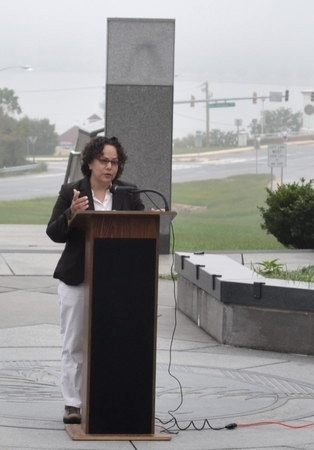
Chair Nancy Sutley delivers remarks at the opening ceremony of Project Green: 9/11 Day of Service and Remembrance. (Photo Credit: Mary McGuirt with the Historic Annapolis Patch)
The day began with a ceremony at the Maryland World War II Memorial to commemorate those who have lost their lives in service. We then joined volunteers, including members of the US Naval Academy Midshipmen Action Group, at Jonas Green Park for clean-up activities including debris collection, weeding, planting native species and controlling storm water runoff to better protect the health of the community and the Chesapeake Bay. Our efforts were focused in the rain garden, where weeding and planting were essential to absorb rain water and improve water quality in the surrounding Bay.
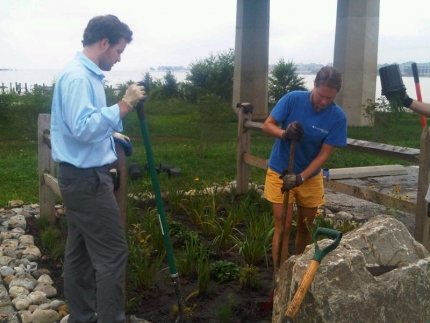
CEQ's Danny Lampton and a local volunteer work in the rain garden just steps away from the Severn River in Annapolis, Maryland.
The effort was part of the Ocean Conservancy’s International Coastal Cleanup, the world’s largest volunteer effort for ocean health. As we got our hands dirty in Jonas Green Park, we were joining nearly half a million others around the world in protecting the coast lines and waterways that are vital to the health of our communities.
The day was a humbling and empowering reminder of what can be accomplished when we draw on our national spirit of unity and service.
Shira Miller and Danny Lampton both work at the Council on Environmental Quality
Protecting Marine Life, Protecting Ourselves
Posted by on September 15, 2011 at 7:00 PM EDT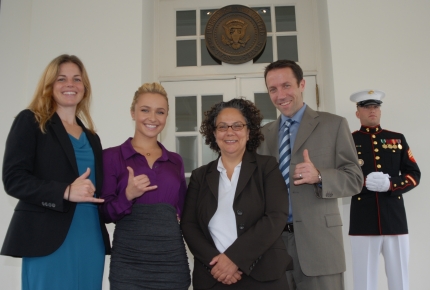
Hayden Panettiere and Administration officials pose after their meeting to discuss conservation of our world’s great whales. (Left to right): Celeste Connors, Director for Environment and Climate Change, National Security Council/National Economic Council; Actress Hayden Panettiere; Nancy Sutley, Chair of the Council on Environmental Quality; and Jay Jensen, Associate Director for Land & Water Ecosystems at the Council on Environmental Quality. (Photo Credit: Jeff Pantukhoff, President & Founder, The Whaleman Foundation)
About 3 years ago, I had the great privilege of meeting President Obama for the first time while he was on the campaign trail. He told me that some of his fondest childhood memories growing up in Hawaii were when he was swimming in the ocean and saw its wondrous creatures up-close and personal, including dolphins and whales. We spoke of the need to protect them and in particular to stop whaling. Today, the Obama Administration took a step toward doing just that.
In a meeting with the President's environmental policy advisor, Nancy Sutley, and several officials from the Administration, I thanked and applauded President Obama for taking action today against Iceland's illegal slaughter of fin and minke whales, which is in direct violation of the International Whaling Commission (IWC) commercial whaling moratorium.
Tens of millions of U.S. citizens, including myself, have written or emailed the President and his Administration supporting these actions under the Pelly Amendment. I am grateful that the President and our government have listened and will be raising this issue with Iceland at the highest levels. They will continue to monitor the companies involved and examine other options available to us.
These include the diplomatic measures just announced here today, such as directing the State Department to examine Arctic cooperation projects, and where appropriate, link U.S. cooperation to the Icelandic government changing its whaling policy and abiding by the IWC moratorium on commercial whaling. It also calls on Iceland to cease its commercial whaling activities.
It has been the policy of the United States to support the conservation of the world's whale populations through science based policies and leadership within the International Whaling Commission. Just recently, the National Oceanic and Atmospheric Administration, which leads the U.S. delegation to the International Whaling Commission, signed a "sister sanctuary" agreement with France to support the protection of endangered humpback whales, and they are currently working with Bermuda to declare a sister humpback whale sanctuary there as well.
Also, at the 2010 meeting of the International Whaling Commission in Agadir, The US delegation, by the request of our organization, introduced a five-year study by Dr. Roger Payne and Dr. John Wise that showed how toxins and pollutants are being dispersed throughout the world's oceans and up the food chain. It outlined how these pollutants are not only a serious health threat to marine life, including apex predators like dolphins and whales, but also pose serious health threats to humans.
By protecting marine life and our oceans, ultimately we are protecting ourselves. President Obama recognizes this and has repeatedly supported innovative and conservation-minded efforts, not only at the International Whaling Commission, but with the unprecedented forward thinking demonstrated in his National Ocean Policy.
Hayden Panettiere is an Actor and the International Spokesperson for The Whaleman Foundation & the Save the Whales Again! Campaign
Learn more about Energy and Environment
- &lsaquo previous
- …
- 20
- 21
- 22
- 23
- 24
- 25
- 26
- 27
- 28
- …
- next &rsaquo
White House Blogs
- The White House Blog
- Middle Class Task Force
- Council of Economic Advisers
- Council on Environmental Quality
- Council on Women and Girls
- Office of Intergovernmental Affairs
- Office of Management and Budget
- Office of Public Engagement
- Office of Science & Tech Policy
- Office of Urban Affairs
- Open Government
- Faith and Neighborhood Partnerships
- Social Innovation and Civic Participation
- US Trade Representative
- Office National Drug Control Policy
categories
- AIDS Policy
- Alaska
- Blueprint for an America Built to Last
- Budget
- Civil Rights
- Defense
- Disabilities
- Economy
- Education
- Energy and Environment
- Equal Pay
- Ethics
- Faith Based
- Fiscal Responsibility
- Foreign Policy
- Grab Bag
- Health Care
- Homeland Security
- Immigration
- Innovation Fellows
- Inside the White House
- Middle Class Security
- Open Government
- Poverty
- Rural
- Seniors and Social Security
- Service
- Social Innovation
- State of the Union
- Taxes
- Technology
- Urban Policy
- Veterans
- Violence Prevention
- White House Internships
- Women
- Working Families
- Additional Issues

